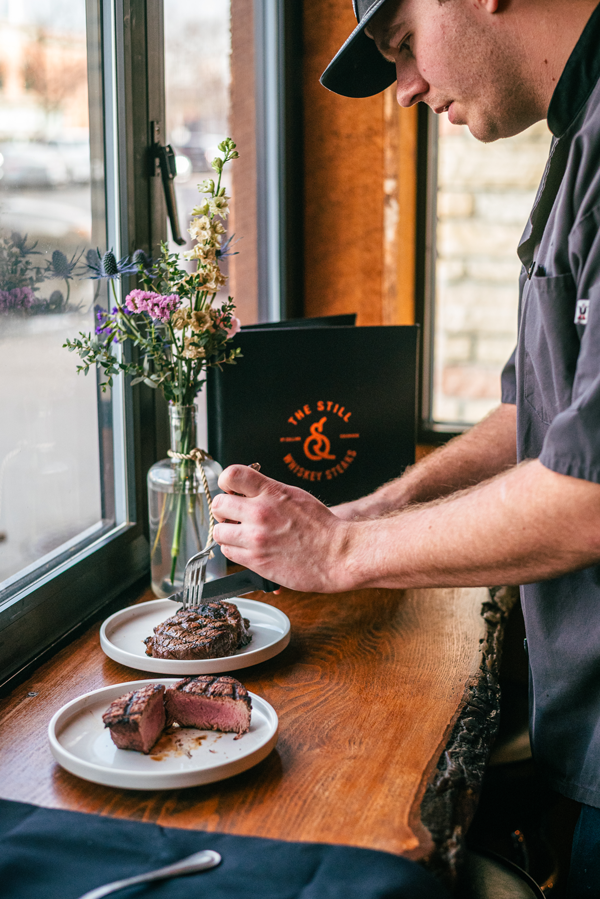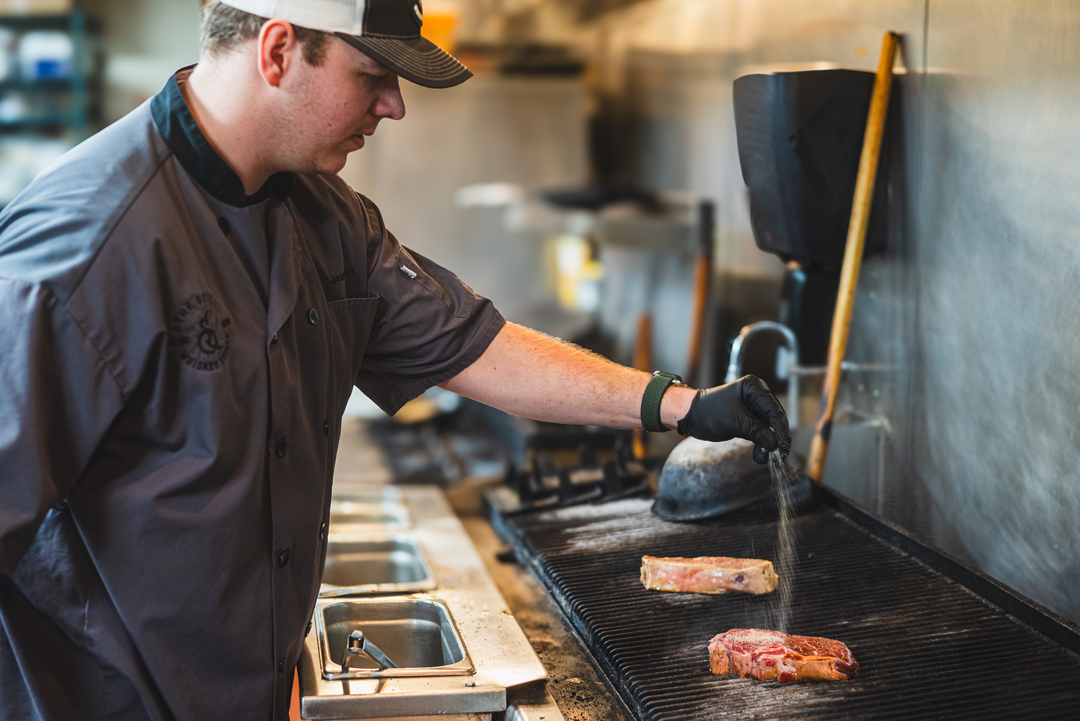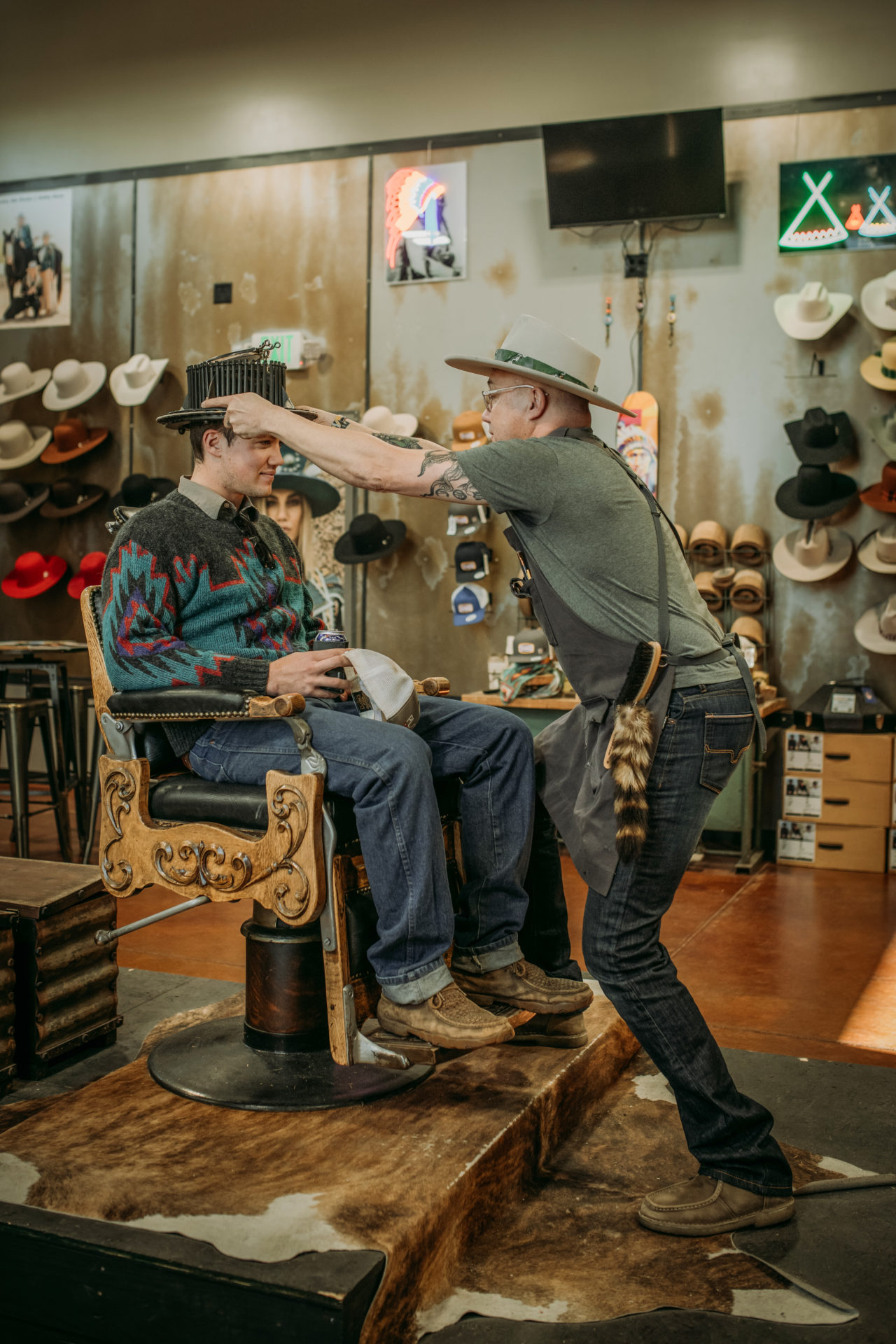Steaks are often expensive cuts of beef, so it’s natural that cooking them at home might make you nervous. After all, you don’t want to burn them into charred, inedible bricks. But if you’re equipped with a quality cut of meat and these tips from local experts, cooking steak makes a delicious meal.
Jaden Ray, a chef at The Still Whiskey Steaks in downtown Fort Collins, suggests choosing from four standard cuts for their distinct tastes and tenderness: New York strip, filet mignon, ribeye and sirloin. Cost plays a big part in the decision as a larger, well-marbled New York strip can be more affordable than a prime eight-ounce filet mignon, but so does your taste. The mignon will be leaner and more tender, but the strip’s fat makes it juicier and more flavorful.
Next, decide whether you will serve sauce with the meat. New York strips and ribeyes can stand alone because their marbling laces the muscle with savory fat. Leaner filets can be enhanced by sauces such as a tangy chimichurri, piquant béarnaise, bourbon cream or red wine reduction with sautéed mushrooms and fresh herbs.
Here, Ray breaks down techniques to prepare his favorite cuts.
New York strip
Ray says the best way to cook a New York strip is to grill it because doing so breaks down the cut’s fat and dense cartilage, making it more tender.
“Marinate for an hour fully submerged (or an hour per side if half-submerged) before grilling,” he says. “Over-marinating changes the flavor and texture.”
Ideally, marinating combines an acid, fat and flavor for a tastier, more tender result. It also adds moisture to the meat, preventing it from drying out.
“Straight whiskey, red wines or other alcohol are the acid,” Ray says. “They help tenderize the meat, but you can use juice from a lemon or other fruits. For home usage, divide the marinade ingredients into three equal parts, including an acid, fat (like olive oil) and flavor, like soy sauce,” he says.
If you can plan ahead, he suggests unwrapping an unmarinated New York strip, brining it with smoked salt, then refrigerating it on a rack for five hours before cooking. Local spice shops, like Savory Spice in Fort Collins, have several smoked salt options.
“The salt pulls out moisture and has a dry-aging effect to break down the fats for that fall-apart texture,” he says. “It can turn an OK steak into something that’s a lot more tender.”
To cook it at home, preheat your grill to 350-400° F (thicker cuts require lower temperatures). Ray recommends cooking the steak to medium rare, about 12-15 minutes. For crosshatch grill marks, grill one side for three or four minutes and flip the steak over for another three or four minutes, making a quarter turn. Then flip it again, turning it to repeat the marking. Periodically use a meat thermometer to accurately gauge the temperature. Remove the steak from the grill and let it rest uncovered on a clean plate for five minutes to pull the juices back into the meat.

The Still Whiskey Steaks. Photo by Jordan Secher.
Ribeye
Ray recommends grilling ribeyes, but you can also pan-sear them slowly on low heat in a cast iron pan or ceramic skillet in olive oil with an aromatic spice crust. Simply combine pantry staples such as salt, pepper, garlic and onion powders and press them onto the meat before cooking it to enhance the flavor.
“Olive oil has great flavor and a mid-range smoke point,” Ray says, although avocado and canola oils, which have varying smoke points and flavors, are good alternatives. If you want to use butter, cook it over low heat or use a pat to finish the steak.
To cook a ribeye indoors, heat the oil in a pan on low heat. Still, the steak should sizzle when you place it in the pan to sear the crust.
Cook the steak to temperature after flipping it to sear the other side, then remove it from the skillet and let it rest for five minutes. If you want an oven finish for thicker cuts, sear the ribeye for two minutes per side on medium heat and finish it in a 350° F oven for five minutes. Using indirect heat cooks meat more evenly, preventing the exterior from burning while the interior reaches your desired temperature.
Filet mignon
This tender, lean cut earns a high dollar because there are only two tenderloins per cow, located in the middle of its back. They are also the most tender cut.
Grilling filet mignon enhances the flavor because of the Maillard reaction, which is what happens when the proteins and sugars in meat combine over high heat, creating a savory taste and browned crust. On the other hand, Ray says pan-searing filets helps retain the juices while creating a crust from the seasoning you choose. Sear each side for two minutes and finish it in a 350° F oven for 12-15 minutes to reach the desired temperature. Let it rest for five minutes before serving.
Sirloin
The lean sirloin is also located on a cow’s back, but it’s firmer, Ray says. This tougher cut is best grilled to prevent chewiness. Marinating it also tenderizes it and adds flavor. Grill a sirloin steak for 12-15 minutes for a medium-rare temperature.
Ray recommends cooking any steak to medium rare. But ultimately, how you enjoy your steak is individual preference.
__________________________________
Steak Temperature Guide
Courtesy of Flying B Bar Ranch, Strasburg
Very Rare: 115-120° F
Rare: 120-130° F
Medium Rare: 130-140° F
Medium: 140-150° F
Medium Well: 150-155° F
Well Done: Why bother?
__________________________________
Where to Find High-Quality Beef

Living Water Ranch Colorado. Photo courtesy of Living Water Ranch Colorado.
Local ranchers sell high-quality meats, focusing on methods that ensure humane treatment of livestock and sustainable environmental practices through the use of natural resources. At Living Water Ranch in Livermore off U.S. 287, Rex Stahla and his wife, Vanessa, produce 100-percent grass-fed and -finished beef with no antibiotics or growth hormones. The Stahlas began ranching their 200 acres 15 years ago after retiring from the oil and gas industry.
“Our beef tastes how it used to be in the olden days,” Rex says. “Our cattle drink from the north Cache la Poudre River running through our property, and they graze off sweet grasses on our land.”
Vanessa touts Living Water Ranch’s beef for its leanness: “It’s less fat, so it’s healthier for the body, and because we don’t finish with grains, the meat doesn’t have GMOs.”
Rex recommends not overcooking lean grass-fed beef. Cooking it to a medium temperature will retain its tenderness, but medium rare is ideal.
The Stahlas sell cattle shares year-round in quarter, half and whole sizes, and a deposit of $250-1,000 is required for a reservation. The total cost is based on hanging weight (about $1,250 for a quarter of beef), which includes vacuum-sealed ribeyes, tenderloins, New York strips, breakfast steaks, stew meat, hamburger meat, brisket and roasts. Orders are for pickup only at an arranged time and place.
Mountain View Meats in Virginia Dale (between Laramie, Wyo., and Fort Collins on U.S. 287) was homesteaded in 1903. Co-owner Nicole Uthmann’s sons are the sixth generation to raise cattle on the ranch. Mountain View Meats raises cattle from calf to finished product on their ranch as well as their Hawk Springs, Wyo., processing facility and at a new store on the farm.
“Our meat is finished on a combination of grains, including distiller’s and brewer’s spent grains, cracked corn, alfalfa, feed-yard grasses and a vitamin/mineral supplement,” Uthmann says. “The ribeye is the most popular because of its flavor. It’s a well-marbled steak, but filet mignon is known for its tenderness.”
The ranch sells beef and pork in half-shares up to three months in advance as well as small bundles, steak boxes, roast boxes and a variety box. Each month, up to six half-shares are available to reserve online, but spots fill up quickly. The total cost runs between $2,100-2,700 for a half beef share. Order online for free delivery or pickup at the Mountain View Meats farm store from 1-5 p.m. Monday, Wednesday or Friday year-round.
Stahla Family Recipes to Try at Home
Courtesy of Vanessa and Rex Stahla, Living Water Ranch
__________________________________
STAHLA FAMILY SECRET MARINADE
1/4 cup Worcestershire sauce
1/2 cup oyster sauce
1/4 cup teriyaki sauce
2 tablespoons Kitchen Bouquet
2 tablespoons liquid smoke
Cavender’s Greek Seasoning to taste, sprinkled on the meat after removing it from the marinade
Let the meat sit in the marinade for at least an hour. Keep the marinade in a Worcestershire sauce bottle since you won’t use the entire bottle for just one recipe. Refrigerate any remaining unused marinade.
__________________________________
Tender Ribeye Steak Sheet Pan Recipe
Serves 4-6
This all-in-one, colorful oven recipe has easy cleanup. Choose a variety of vegetables to add to your pan, like red potatoes, green beans and red and yellow bell peppers, or change it up with zucchini, cherry tomatoes or asparagus.
Ingredients
1½-3 pounds grass-fed ribeye steak (marinated in a large bowl with the Stahla Family Secret Marinade for one hour, or marinate it in the refrigerator overnight)
1 bag fresh or frozen green beans
1 pound red potatoes, quartered or smaller if it’s a large potato (toss in olive oil and seasonings and microwave the quarters for about 10 minutes to soften)
1 red bell pepper, sliced into thin rounds
1 yellow bell pepper, sliced into thin rounds
¼ cup olive oil
2 cloves minced garlic or 1 teaspoon garlic powder
1 tablespoon sea salt
1 teaspoon ground black pepper
Method
Line a jelly roll pan with heavy-duty foil sprayed with cooking oil. Preheat the oven to 400° F.
Toss the vegetables in a gallon-size Ziploc bag with olive oil, garlic or garlic powder and salt and pepper. Roast them on the foil-lined pan for 30 minutes.
Remove the steak from the marinade and season it with salt and pepper. Discard any leftover marinade.
Scooch the vegetables over and place the ribeye in the center of the pan without overlapping the pieces if there is more than one piece of beef.
Increase the oven temperature to broil and cook, watching closely until the meat reaches the desired doneness.
Using a meat thermometer, cook to 125° F
for rare, 135° F for medium rare or 140° F for medium.
Slice the ribeye into desired proportions and serve.
__________________________________
CAST IRON SKILLET FLANK STEAK
Serves 4-6
“We love this quick and easy recipe when it’s too cold outside to grill,” Vanessa says. Marinate two-to-three pounds of grass-fed flank steak at room temperature for at least an hour, or overnight in the refrigerator.
Ingredients
2-3 pounds grass-fed flank steak, cut into four pieces
5 tablespoons butter
3 teaspoons canola oil
4 garlic cloves, minced
8 ounce package baby portabella mushrooms, sliced
Kosher salt and ground black pepper to taste
¾ cup dry red wine
Cavender’s Greek Seasoning to taste
Method
Preheat the oven to 400° F. Remove the steaks from the marinade and season them generously with Cavender’s Greek Seasoning, then discard the used marinade.
In a large cast iron skillet, heat the oil over medium-high heat until it’s very hot. Add 2 tablespoons butter and sear the steaks quickly on both sides. Place the skillet in the oven and cook it until the internal temperature is 135° F, about four minutes.
Take the skillet out of the oven and return it to the stovetop. Remove the steaks and set them aside on a cutting board to rest.
Add two tablespoons of additional butter to the skillet and add the sliced mushrooms, sautéing for five minutes over medium heat. Add the garlic, red wine and any of the juices from the resting steak to the skillet, then turn the heat to medium high, bringing the mixture to a boil. Sauté for an additional five minutes, scraping the bits of goodness on the bottom of the pan until you have a thick reduction. Add an additional tablespoon of butter to the liquid.
Slice the rested flank steak against the grain at an angle into 1½-inch to 2-inch slices and pour the mushrooms and sauce over the meat. Serve with baked potatoes.







